SomnusNooze
Happy Fall! If you’ve missed any of the latest news we’ve shared through our social media, don’t worry! Get up to date with this edition of “In Case You Missed It!”
- TWO GREAT VIDEOS: “Science” magazine releases video about life with IH and the use of artificial intelligence to diagnose sleep disorders; and watch a TikTok of a young IH patient’s sleep study.
- TWO GREAT READS: “Sleep Lab Magazine” talks about living with IH, and “Healthier Sleep Magazine” focuses an entire issue on daytime sleepiness.
- SHARE YOUR STORY: Opportunity to share your experiences on a wide range of issues impacting the rare disease community.
- NOW RECRUITING: Please recruit your Atlanta-area friends and family who are normal sleepers ages 18 – 45 for Emory University’s ongoing hypersomnia study!
- THANK YOU: People living with IH share why they are thankful for their supporters.
- INTERESTING READ: Learn about the negative effects of daylight saving time.
Don’t worry if you’ve missed anything. We’ve got you covered!
TWO VIDEOS WORTH WATCHING AND SHARING
“Science” Magazine Releases Video About Life With IH and the Use of Artificial Intelligence to Diagnose Sleep Disorders
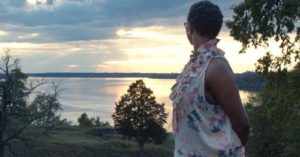 The online edition of “Science” magazine recently released a video article about the difficulties of treating and diagnosing idiopathic hypersomnia. It discusses new techniques using artificial intelligence that could soon help diagnose poorly defined sleep disorders, including IH.
The online edition of “Science” magazine recently released a video article about the difficulties of treating and diagnosing idiopathic hypersomnia. It discusses new techniques using artificial intelligence that could soon help diagnose poorly defined sleep disorders, including IH.
The video follows Victoria Kirby York of Fort Washington, Maryland, as she discusses living with IH, and also includes interviews with Dr. Emmanuel Mignot, Professor of Sleep Medicine at Stanford University; Dr. Lynn Marie Trotti, Associate Professor of Neurology at Emory University; and Dr. Chiara Cirelli, Professor at the University of Wisconsin-Madison.
Young IH Patient Shares Sleep Study on TikTok
We love this video of a pediatric sleep study and wish this young patient all the best!
TWO GREAT READS ABOUT LIVING WITH IH
“Sleep Lab Magazine” Talks About Living With IH
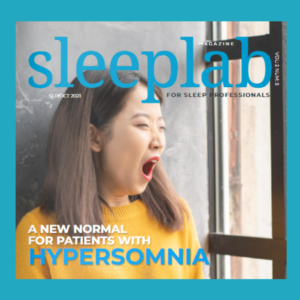 “Sleep Lab Magazine” recently published an article, entitled “A New Normal for Patients With Hypersomnia,” which interviews Casey Bento, a 28-year-old corrections officer living in New York, who was diagnosed with IH four years ago. The article shares Casey’s struggle living with IH and her path to a working treatment protocol. It also provides an IH overview and information about available treatments.
“Sleep Lab Magazine” recently published an article, entitled “A New Normal for Patients With Hypersomnia,” which interviews Casey Bento, a 28-year-old corrections officer living in New York, who was diagnosed with IH four years ago. The article shares Casey’s struggle living with IH and her path to a working treatment protocol. It also provides an IH overview and information about available treatments.
The magazine also features a sidebar article on the Hypersomnia Foundation, which highlights our mission, free resources and educational materials, efforts to increase awareness of IH and other sleep disorders, and our CoRDS International Patient Registry, on which, to date, 3,107 people with rare sleep disorders have shared their data. The goal of the CoRDS registry is to connect as many patients and researchers as possible to help advance treatments and cures for rare diseases.
A PDF of “Sleep Lab Magazine” is available HERE; then flip to page 11 to read “A New Normal for Patients With Hypersomnia.”
“Healthier Sleep Magazine” Focuses on Daytime Sleepiness
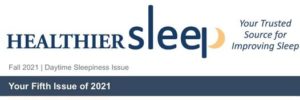 The theme of the most recent issue of World Sleep Society’s Healthier Sleep Magazine is “Daytime Sleepiness.” This free online magazine has articles about healthy sleep and the sleep disorders that affect millions worldwide. The autumn issue discusses the latest advancements in sleep science and medicine, how sleep disorders are treated, how sleep impacts the body and mind, and why we need to sleep in the first place.
The theme of the most recent issue of World Sleep Society’s Healthier Sleep Magazine is “Daytime Sleepiness.” This free online magazine has articles about healthy sleep and the sleep disorders that affect millions worldwide. The autumn issue discusses the latest advancements in sleep science and medicine, how sleep disorders are treated, how sleep impacts the body and mind, and why we need to sleep in the first place.
Healthier Sleep is a completely free resource for patients and the public. Print and digital publication is supported by World Sleep Society, with the mission to advance sleep health worldwide. Each issue is reviewed by an impartial team of physicians who are experts in sleep science and medicine.
SHARE YOUR EXPEREINCES ON A WIDE RANGE OF ISSUES IMPACTING THE RARE DISEASE COMMUNITY
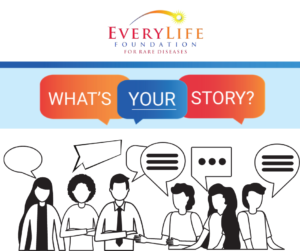 More than 30 million Americans are living with one or more rare diseases. Each one of us has a story and the EveryLife Foundation for Rare Diseases wants to hear yours—the patients, families, caregivers, healthcare professionals, researchers and policymakers whose lives have been impacted by rare disease.
More than 30 million Americans are living with one or more rare diseases. Each one of us has a story and the EveryLife Foundation for Rare Diseases wants to hear yours—the patients, families, caregivers, healthcare professionals, researchers and policymakers whose lives have been impacted by rare disease.
They have launched “What’s Your Story?”—a new online rare disease story bank for people to share their experiences on a wide range of issues impacting the rare disease community. On their website, you will be presented with a series of questions covering topics ranging from difficulty in getting diagnosed to challenges in gaining access to therapies, to facing discrimination in the workplace, and more. You are also invited to upload photos and videos that help illustrate your rare disease journey. Advocates of any age are welcome to submit stories.
The deadline to submit your story is March 2nd, the final day of Rare Disease Week on Capitol Hill 2022. Everyone who submits a story will be entered to win a $1,500 donation to the patient advocacy organization of your choice.
PLEASE RECRUIT YOUR ATLANTA-AREA FRIENDS AND FAMILY WHO ARE NORMAL SLEEPERS AGES 18-45 FOR EMORY UNIVERSITY’S ONGOING HYPERSOMNIA STUDY
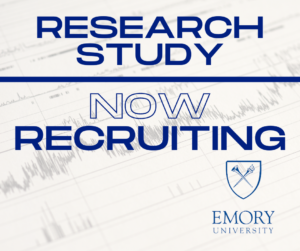 Please recruit your Atlanta-area friends and family who are normal sleepers ages 18 – 45! They’ll get paid to help Dr. Lynn Marie Trotti’s research team as control subjects for their ongoing study of Hypersomnias and the Microbiome (investigating how the microorganisms in the gut might affect sleepiness). Participation involves a visit to the Sleep Center (12 Executive Park, Atlanta, GA, 30329) for questionnaires and a blood draw, and collecting a stool sample at home to bring back to the Sleep Center. Total time is estimated at one hour.
Please recruit your Atlanta-area friends and family who are normal sleepers ages 18 – 45! They’ll get paid to help Dr. Lynn Marie Trotti’s research team as control subjects for their ongoing study of Hypersomnias and the Microbiome (investigating how the microorganisms in the gut might affect sleepiness). Participation involves a visit to the Sleep Center (12 Executive Park, Atlanta, GA, 30329) for questionnaires and a blood draw, and collecting a stool sample at home to bring back to the Sleep Center. Total time is estimated at one hour.
If you are a good sleeper without any diagnosed sleep disorders, please contact Natalie Fernandez (404-778-6114 or ) or Dr. Trotti () for more information. Visit our Research Studies page for information about THIS and other currently recruiting trials.
PEOPLE LIVING WITH IH SHARE WHY THEY ARE THANKFUL FOR THEIR SUPPORTERS
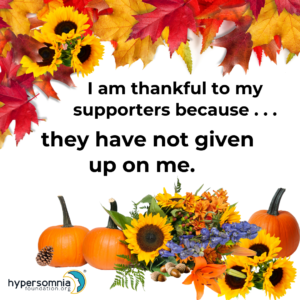 November is a month for giving thanks. We asked those living with IH and related sleep disorders why they are thankful for their supporters and shared their comments throughout our social media. Here’s what they had to say:
November is a month for giving thanks. We asked those living with IH and related sleep disorders why they are thankful for their supporters and shared their comments throughout our social media. Here’s what they had to say:
I am thankful to my supporters because….
- Our disorder may be invisible but you see me and automatically understand the “you too” challenges of living with idiopathic hypersomnia.
- I couldn’t do it without them—my family, friends, and other people with IH.
- They believe in me.
- They are part of my IH journey on good days and bad days.
- They have not given up on me.
- They give me good energy and understanding when IH impairs me.
Thank you to all the supporters out there who play an important role in the lives of people with a sleep disorder. Supporters, please know you are seen and appreciated!
THE NEGATIVE EFFECTS OF DAYLIGHT SAVING TIME
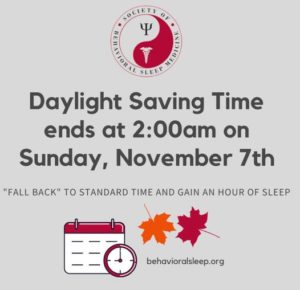 We recently experienced the annual ritual of retuning to standard time. Clocks reset to one hour earlier, with everyone gaining one hour of extra sleep. We “fall back” to standard time until we once again “spring forward” into daylight saving time, which begins the second Sunday in March.
We recently experienced the annual ritual of retuning to standard time. Clocks reset to one hour earlier, with everyone gaining one hour of extra sleep. We “fall back” to standard time until we once again “spring forward” into daylight saving time, which begins the second Sunday in March.
Many advocates, including sleep medicine professionals, would like to see daylight saving time abolished. These advocates, including the American Academy of Sleep Medicine, note that daylight saving time itself, plus the transitions to and from it in the spring and fall, leads to public health and safety concerns. Learn more about the negative effects of daylight saving time in AASM’s position statement in the Journal of Clinical Sleep Medicine.
